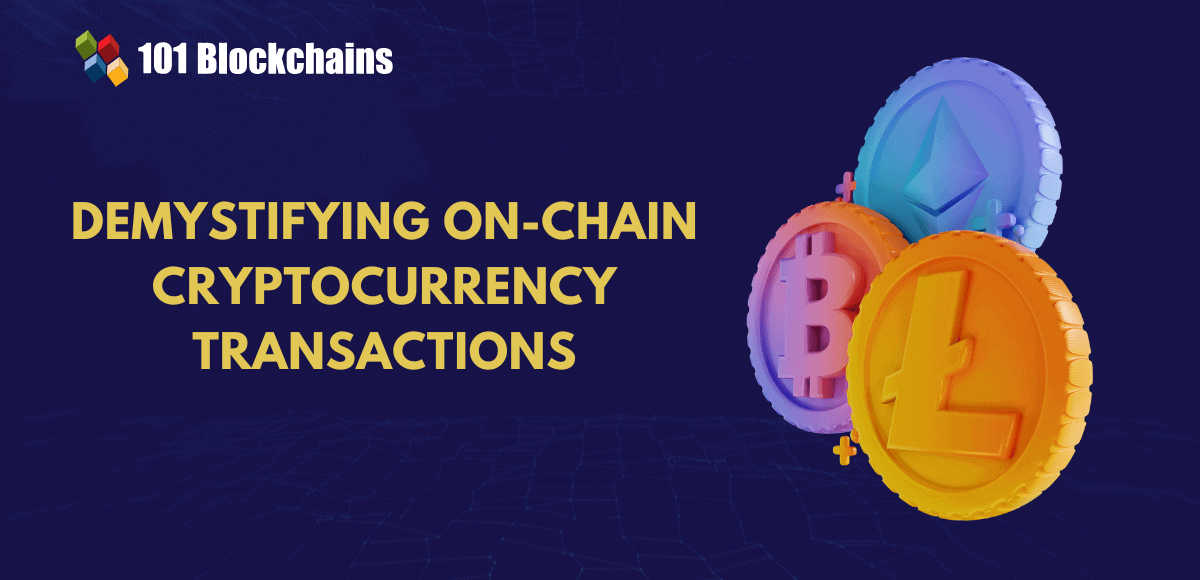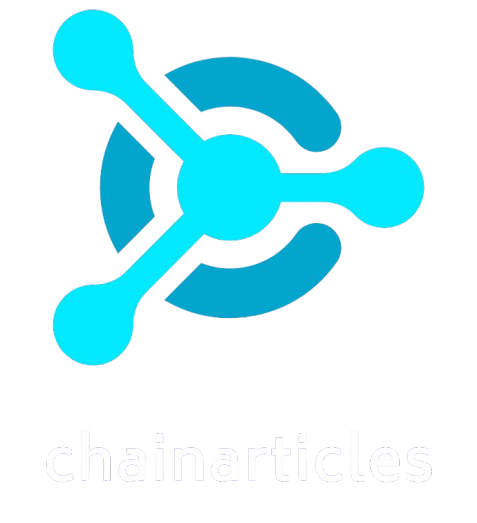In the dynamic blockchain environment, having a clear understanding of on-chain cryptocurrency transactions is essential. These transactions are integral to the functionality and security of blockchain technology. On-chain transactions refer to cryptocurrency transactions recorded directly on the blockchain ledger.
What makes these transactions unique is their permanence in the immutable ledger. Once these transactions are validated and confirmed, they become a part of the main blockchain network. Let’s explore on-chain cryptocurrency transactions in greater detail.
Build your identity as a certified blockchain expert with 101 Blockchains’ Blockchain Certifications designed to provide enhanced career prospects.
Mechanism of On-Chain Cryptocurrency Transactions
On-chain cryptocurrency transactions represent the process of transferring digital currencies directly within blockchain networks. A particular mechanism is followed in these transactions, ensuring that they are recorded and verified in a secure way. Below are the key steps involved in on-chain cryptocurrency transactions:
The basic step involves the initiation of a transaction. This occurs when a user intends to send cryptocurrency to another user. The transaction is initiated via their digital wallet.
On-chain transactions may contain important details, including the sender’s and receiver’s wallet addresses and the amount being sent. It must also contain a digital signature to verify the identity of the sender.
After the initiation of the transaction, it is broadcasted to all nodes in the network. This means that the information about the transaction is sent to all nodes within the blockchain network.
Each node plays a crucial role at this stage. Each node is responsible for maintaining a copy of the blockchain. Moreover, it must take part in the validation process of the transaction.
-
Validation and Consensus
After a transaction is broadcast, it becomes a part of the mempool. A mempool is a temporary queue containing unconfirmed transactions. Nodes use a consensus mechanism to validate transactions.
The two common methods of the consensus mechanism are proof of work (PoW) and proof of stake (PoS). The PoW method involves miners solving complex mathematical puzzles. It ensures transaction legitimacy and prevents double-spending. In the PoS method, validators can create new blocks based on the cryptocurrency amount they hold and the amount they wish to stake as collateral.
After the validation process comes to an end, a transaction is put along with other transactions into a block. Every block has a number of transactions, a reference to the former block, along with a distinctive cryptographic hash. The existence of such linking ensures the creation of an immutable and safe chain.
-
Confirmation and Finalization process
It involves the addition of the new block to the blockchain network. This process is called confirmation. It makes the particular transaction permanent in nature. As a result, no one can alter it in any manner.
The total number of confirmations received by a transaction impacts its level of security. Typically, a higher number of confirmations implies a higher security level of the specific transaction.
Advantages of On-Chain Transactions
On-chain crypto transactions have several advantages. You need to know these advantages to understand why these transactions are called the backbone of blockchain technology. The major strengths of these transactions, which contribute to their rising popularity in the crypto community, are:
One of the main advantages of on-chain transactions revolves around their top-quality security. They are highly secure since they cannot be changed or altered after being recorded within the blockchain network. Due to this feature, it is nearly impossible to manipulate or tamper with transactions. A highly popular example of an on-chain transaction with a high level of security is Bitcoin.
Another important advantage of on-chain cryptocurrency transactions is related to their transparent nature. Since all the transactions are recorded in a public manner it is possible for everyone to check them. There exists a high level of transparency as all details are visible to everyone. Thus, such transparency creates trust among users within the blockchain network.
You should be able to answer the question – ‘What is on-chain analysis in crypto?’ to make the most of the transparent setting. By conducting such analysis, you can examine data within the network and gain valuable insights into market trends.
-
Eliminated need for central authority
The concept on which on-chain transactions are based undoubtedly eliminates the need for a central authority. As all the data and details are stored within the network, an environment of trust is built. Such decentralization makes sure that no single authority has the power to control the system. Therefore, on-chain transactions enhance the overall integrity of the blockchain system.
Excited to learn the basics of cryptocurrency and the ways in which blockchain technology empowers cryptocurrencies, Enroll now in the Cryptocurrency Fundamentals Course
Disadvantages of On-Chain Transactions
It is important to bear in mind that on-chain transactions come with certain disadvantages, which users must understand. By understanding these drawbacks, you can gain a comprehensive understanding of on-chain transactions. Some of the key disadvantages of these transactions include
-
Concerns regarding scalability
One of the main disadvantages is related to scalability. Since these transactions require a consensus mechanism at the network-wide level, the transaction speed may decline. Moreover, as the chain expands, the need for resources to maintain and validate the transactions may increase substantially. Hence the network may ultimately become inefficient owing to the scalability challenges.
Another major disadvantage of on-chain transactions centers around high cost. Users who wish to engage in such cryptocurrency transactions generally have to incur certain fees. Furthermore, the fees may be high for users if they choose blockchain networks with a high congestion level. For small-scale users the high cost relating to on-chain transactions may act as a barrier. Similarly, if individuals wish to conduct transactions of small value, the high cost may act as a major hurdle for them.
The high transparency in on-chain cryptocurrency transactions has the potential to give rise to privacy concerns for users. This is because all the transaction details are directly available for everyone to see within the blockchain network. The absence of privacy is a drawback for users who are looking for confidentiality within the network.
Enroll now in the Blockchain Scalability and Interoperability Mastery Course to learn the skills needed to develop faster, scalable, robust, and interoperable dApps.
What makes On-Chain Transactions different from Off-Chain Transactions?
While on-chain transactions take place within the main blockchain, off-chain transactions occur outside it. As a result, off-chain transactions are not recorded immediately on the network. Due to this feature, these transactions are not only faster but also cheaper than on-chain cryptocurrency transactions.
Users of cryptocurrencies need to know the difference between these two types of crypto transactions to make the appropriate selection. Some of the main differences between on-chain and off-chain transactions include:
-
High speed of transaction
One of the chief points of difference between on-chain and off-chain cryptocurrency transactions is related to transaction speed. The speed of on-chain cryptocurrency transactions is low, whereas the speed of off-chain transactions is high. While on-chain transactions need to wait for validation and confirmation, off-chain transactions do not have to wait for the same. Thus, the processing of off-chain crypto transactions is almost instant.
Another thing which gives rise to the difference between on-chain transactions and off-chain transactions is related to the cost factor. Off-chain transactions are undoubtedly a much more affordable option for users. These transactions typically involve no fees for users. On the other hand, users who wish to engage in on-chain cryptocurrency transactions have to incur high fees for the same.
The risk involved in on-chain transactions is much lower than the risk in off-chain transactions. One of the main concerns users of off-chain transactions have to face revolves around a low level of transparency. Since the recording of the transactions is not immediate, concerns regarding transparency arise. Similarly, off-chain transactions may have higher vulnerability when it comes to fraud. This risk may arise due to the presence of limited security features in the case of on-chain transactions.
Start learning Blockchain with World’s first Blockchain Career Paths with quality resources tailored by industry experts Now!
When to Choose On-Chain Transactions
Since you have familiarized yourself with on-chain transactions, you may be wondering when to choose them. If so, you need to keep in mind the following points. They will definitely help you derive the most value from on-chain cryptocurrency transactions.
If you wish to engage in high-value transactions, you must choose on-chain transactions over off-chain transactions. On-chain crypto transactions are ideal in these scenarios thanks to their high security and transparency. There is no need to worry about fraud, as their top-notch security makes them an ideal choice for users.
However, if users wish to engage in regular or day-to-day transactions on the blockchain, they can opt for off-chain cryptocurrency transactions. Since these transactions are fast and affordable, they are the perfect option for such transactions. If you want to make payments of small value, you can certainly choose off-chain transactions. Thus, these two types of crypto transactions are ideal for different scenarios and situations. You need to carefully choose them depending on the type of transaction you wish to do.
Conclusion
Within the blockchain network, on-chain cryptocurrency transactions play a major role for users. These transactions ensure top security and transparency while removing the reliance on a centralized authority. A proper understanding of the underlying Mechanism of On-Chain Cryptocurrency Transactions is essential for every crypto user. The working of these crypto transactions involves a series of processes, including initiation of a transaction, broadcasting of transaction, validation and consensus, addition in a block and confirmation and finalization process.
In order to understand on-chain cryptocurrency transactions at a holistic level, you must consider their advantages and disadvantages. As a crypto user, you need to take these aspects into account when choosing transactions. Furthermore, you must also carefully consider the core features of on-chain and off-chain cryptocurrency transactions so that you can choose the suitable transaction type to meet your specific needs.
*Disclaimer: The article should not be taken as, and is not intended to provide any investment advice. Claims made in this article do not constitute investment advice and should not be taken as such. 101 Blockchains shall not be responsible for any loss sustained by any person who relies on this article. Do your own research!






